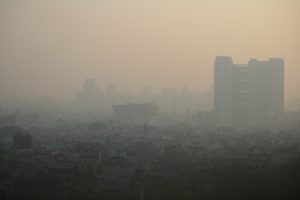As the lives lost to COVID-19 edge closer to 5 million globally, policymakers have demonstrated sharply growing interest in how protecting biodiversity, mitigating climate change, and addressing other planetary crises can improve public health. One planetary crisis that benefited temporarily from COVID-19 lockdowns but requires more sustainable solutions is air pollution. According to 2019 data, air pollution accounted for about 6.75 million premature deaths. While all regions need to step up efforts to reduce this figure, Asia and the Pacific – a region where about 90 percent of its population, or 4 billion people, are exposed to levels of air pollution posing a significant health risk – has the most to gain from concerted efforts to clean the air.
Earlier this month, more than 500 policymakers, researchers, and representatives from the development community convened for a set of virtual interactive sessions as part of the Third Asia Pacific Clean Air Partnership (APCAP) Joint Forum. The Joint Forum is an event organized by the United Nations Environment Program to help showcase and share innovative approaches to controlling air pollution. A key message that emerged from the Joint Forum and should resonate far beyond the environmental community is that breaking down boundaries between countries, regions, and stakeholders is critical to a healthy planet and people.
Some of the air pollution solutions that can help protect the planet and people are well known in Asia. Many of the main sources of harmful emissions come quickly to mind, such as coal-fired plants or motorized vehicles. Recent efforts to phase down coal, curb fossil fuel subsides, or introduce electric vehicles, some of which have gained momentum due to green recovery programs, should be continued. Similarly, policies aimed at promoting more active lifestyles in cities with improved cycling and walking infrastructure also need support from policymakers and politicians.
There is encouraging evidence to suggest that policymakers in some parts of Asia are keen to advance these solutions. For example, Indonesia’s national government allocated resources to electric vehicles, while cities such as Pasig in the Philippines extended bike lanes in the wake of COVID-19. Greater integration between air pollution, climate, and energy policies in the post-COVID era in Asia can arguably maintain this momentum and retain some of the air quality improvements witnessed during lockdowns. Greater experiences sharing across countries and cities the region on how stimulus can support these solutions would also be useful.
Because many of the sources of air pollution are not related to industrialization and urbanization, however, focusing only on energy and transport policies will not offer sustainable solutions to air pollution in Asia. Instead, research shows that burning agricultural residue (to accelerate harvesting cycles), the burning of waste (in areas without appropriate waste management facilities), and the use of biomass in wood-fired cook stoves (more on this below) contribute significantly to air pollution in the region. Moreover, many of the solutions to these issues require recognizing that they are closely linked to lifestyles and sociocultural practices that cannot be easily altered with top-down government regulation. Here, too, there is some encouraging news. For instance, the furniture retailer IKEA has promoted a project in India in cooperation with international partners to manufacture rugs from agricultural waste, while selling wheat straw as livestock feed, and considering the reuse of agricultural residues as energy.
Yet if policymakers want to make progress on air pollution, they need to think about solutions that cut across urban and rural administrative borders. One of the other core insights from the Joint Forum is that many of the main sources of urban air pollution come from beyond city borders. For example, it is difficult to prevent air pollution episodes in Bangkok, Thailand because urban and rural sources mix together, forming a toxic brew that is more challenging to manage because of its multiple origins. It will therefore be increasingly critical that cities and rural areas become more adept at coordinating responses at the airshed level – an approach that has found some success in China, as local governments worked to coordinate air pollution controls across cities and provinces. Similarly, these responses would benefit from combinations of government-led policies to address conventional energy, industrial, and transport-related air pollution sources with resources to spread and scale innovative solutions to open burning and cookstoves.
A final message emerging from the Joint Forum is that the fight against air pollution requires not only working across physical boundaries but including diverse stakeholders. In this context, it merits highlighting that the air pollutants emitted from cook stoves often have the most debilitating impacts on the health of women and children. This is because women and children frequently spend more time in close proximity to emission sources. The World Health Organization (WHO), for instance, reported that for women in low- and middle-income countries, household air pollution is the single leading environmental health risk and a main cause of non-communicable diseases.
Yet, women and youth are not simply passive victims of air pollution; they can also be empowered to be part of the solution. For example, in Laos, development partners and civil society groups set up programs that engaged disabled women in the manufacturing and sales of improved cookstoves. More generally, there need to be creative approaches to bringing women and youth into decision-making processes that can help ease shifts to new technologies and social practices.
Overall, the message that will register most strongly for us from the Joint Forum is that cleaning up the air in Asia is increasingly about development choices made by governments, civil society, business, and people from different backgrounds and experiences to be sustainable. Solutions that break down boundaries between these different actors are essential to cleaning the air for all.

































